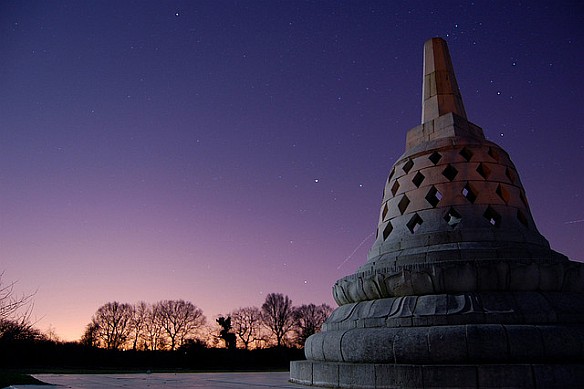
Stupa at Amaravati Buddhist Monastery. Source
Part 1 of 2 of my personal reflections on an eleven-day stay in Amaravati
For me, it was my summer vacation – to continue to look for more freedom.
Freedom – we all want that; we want it dearly. To the point that, in this modern age, our Dutch Constitution (where I’m from) secures many myriad forms of freedom. With that in mind, one cannot be surprised that using our free time is one of the major forms of exercising that freedom. For me, it was my summer vacation – to continue to look for more freedom. In doing so, a lot of us don’t go beyond the ‘sun, sea and beach’ of -do-whatever-you-want, or the endless testing of physical limits with extreme sports. Nevertheless, there are others like myself who chose to retreat, looking for calm and simplicity, for an environment to test one’s inner limits. For that very purpose, I crossed the border last summer to go to Amaravati, a quiet Theravada monastery in the tradition of Ajahn Chah and Ajahn Sumedho.
So there I was, 9:00 A.M. on a Monday morning – the terrain was desolate – surrounded by wooden structures without much ado, some grass, some trees, and most of all: silence. Cell phones don’t work very well here and the village, Hemel Hempstead, where Amaravati lies next to, is quite unknown. Yet, I did not stand there without any baggages. I not only have a backpack with just enough clothes and too many books, but also had a busy year in which I was constantly studying, working, being productive, solving problems etc… proving that I could do it all.
Of course, the monastic campus was not really desolate. After awhile one of the monks – it happened to be the Guest Prefect, noticed me and came by. He showed me the dorm and told me his substitute would give me more explanations and show me around. I fell in love with the dorm: The beds were all low – really low: 5 cm above the ground, and a simple altar. Later, the substitute Guest Prefect showed me around the dining hall, the temple hall, and the field with the stupa (with the hint that from the back of the field one can go for a nice, long walk). He was very open and relaxed. And, what I really appreciate in people who have practiced in the Dharma for a long time was that he didn’t have the need to talk. In contrast, many people in the ‘normal’ world, myself included and also other Buddhists, there is a lack of courage to be silent and all too often a lack of confidence and freedom.
It was remarkable to see the joy from these people by giving to a community that embodies ideals they admire.
When lunchtime was getting closer, the grass fields at the gate quickly were filled with cars. Lunchtime broke the silent atmosphere: a large group of mostly Asian Buddhists came by to bring dana – gifts, in this case, mostly food which they then also ate themselves. It was remarkable to see the joy from these people by giving to a community that embodies ideals they admire. Every day, they come to give, unannounced. Naturally, there were more people on the weekends and especially on Sundays during the vassa (rain retreats) when there were lectures in the afternoon.
Besides the daily group of generous lay people, the community of Amaravati consists of a group of monks, several nuns and residential lay people. Some of the laity stayed for a short time, others longer, and some even undecided. There were those for whom, like myself, the stay was a ‘holiday’, and for others, it was more of a sabbatical. For some, it was a phase before perhaps taking up a monastic life. It was both a diverse and a relaxed group of people. The daily schedule was also at least from my point of view quite relaxed. The day started at 5:00 A.M. with an hour of meditation and then some recitation. Afterwards, people did their chores (6:30 A.M. – 7:15 A.M.), after which there was a simple breakfast. During and after breakfast, usually the abbot – Ajahn Amaro – or another monastic, sat in front of the common room, available for people to ask questions. At 8:15 A.M. there was a work-meeting after which one would work, with a break, until 11:00 A.M.
11:30 A.M. was mealtime, the moment of ‘exchange’ between the lay community and the Sangha. The Sangha first recited blessings of gratitude, oftentimes dedicated according to the wishes of the donors. Thereafter, two or three monks went to the counter where they symbolically ‘received’ the food by taking it over and putting it down again when donors presented it. The Sangha then took the food and went away to eat in silence.
